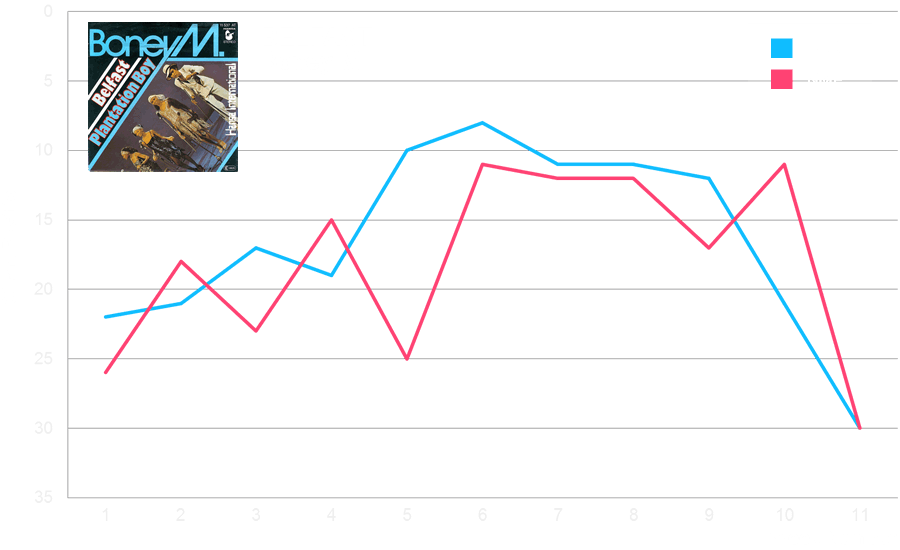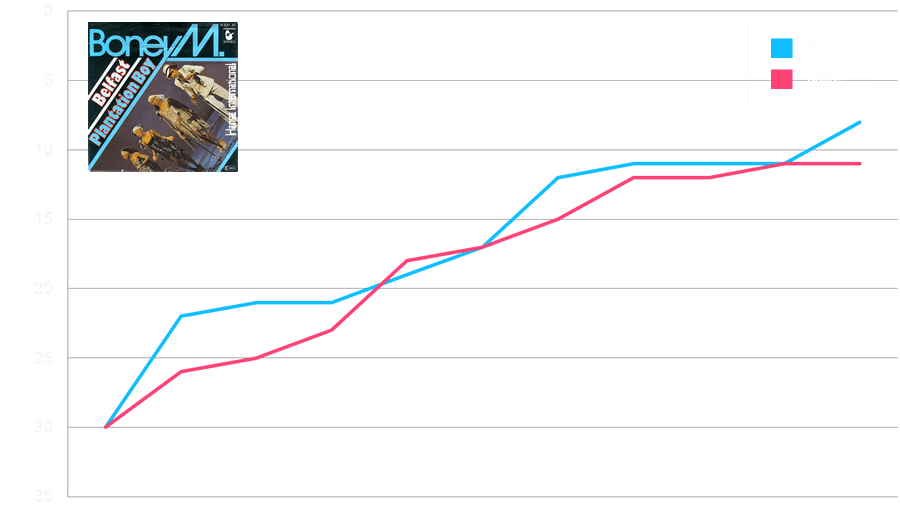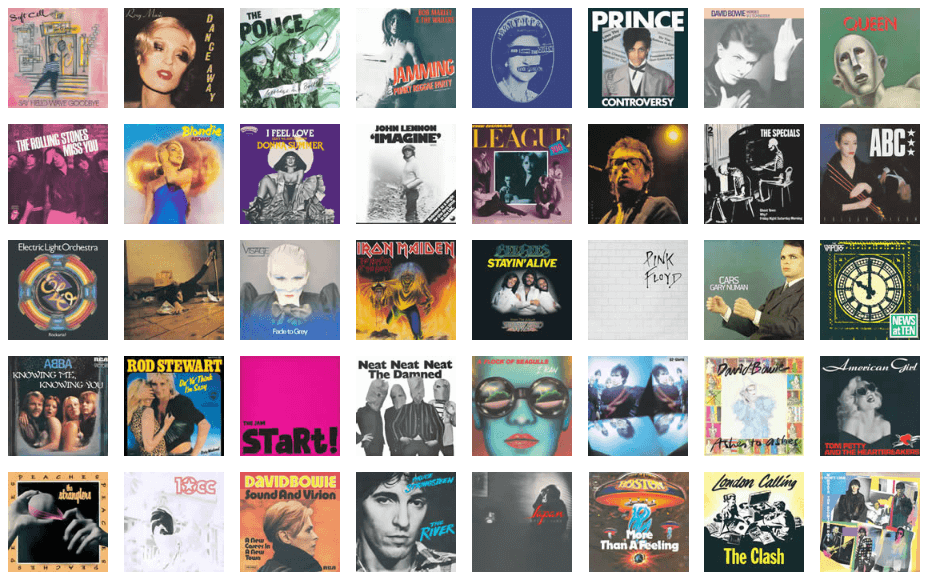Unofficially For You
Or Why We Also Cite NME Charts
We publish two peak chart positions for each single instated on The Wall. The first is from the official chart used by the BBC, Music Week and The Guinness Book of Hit Singles – this was compiled by market researchers BMRB and, from January 1983, Gallup. The second is taken from the New Musical Express (NME) newspaper. You might think this is like the old saying: a man with one watch knows the time but a man with two is never sure. To explain why we use both, we need to first delve into the history of the British charts.
Early Beginnings
The first record-sales based chart was published in the UK on 15 November 1952 by the NME. The paper established a list of 53 record stores, mostly in the London area, willing to record sales. In the early days, a random sample of approximately 20 stores was contacted each week for a list of their 10 bestselling records. The list and geographic scope continually expanded and by the mid-1960s as many as 200 stores would be phoned for weekly sales data. At this time, the NME chart had the largest audience reach with a weekly circulation of 300,000 and was the most highly regarded in the industry.
The 1960s
By the end of the 1960s, there were at least four separate charts published by different newspapers. The industry standards were the ones compiled and published by NME and Melody Maker, which sampled a larger number of stores. The NME even differentiated between double A-side tracks depending on which particular song was requested by the customer when the record was purchased. Record Retailer was the first to publish a Top 50 but used the smallest sample, leading to many records being tied at the same position, which was broken by giving precedence to the record with the biggest growth in sales compared to the previous week.
The Official Chart
Record Retailer (later Music Week) championed the creation of an official chart for the entire industry. Inaugurated in February 1969 and compiled by market research firm BMRB, it sampled a larger number of record stores, initially 250, which increased over time. Reflecting its fierce independence, the NME continued compiling its own, but the official chart was used by the BBC radio and television, making the NME listing very much the poor relation, seen only by music enthusiasts who read the newspaper. In May 1988, after 36 years and almost 2,000 listings, the NME abandoned its own chart, which for most of its existence was a Top 30 (see Table 1). The newspaper eschewed the official countdown compiled by Gallop and published the charts compiled by the Music Research Information Bureau (MRIB), which combined record sales and commercial radio airplay, and were broadcast by the Network Chart Show.
| Chart | First Publication | No. of Charts |
|---|---|---|
| NME Top 12 | 15 November 1952 | 95 |
| NME Top 20 | 2 October 1954 | 72 |
| NME Top 30 | 14 April 1956 | 1,400 |
| NME Top 50 | 23 April 1983 | 257 |
| MRIB Top 50 | 14 May 1988 | - |
Chart Returns
The modern chart, compiled by the Official Charts Company, is virtually a census; fully integrated electronic sales systems mean is possible for computers to collate sales returns from almost every record store in the country. However, this was not the case in the 1970s and 80s, when the official chart was compiled from mailed-in returns of sales diaries from a random sample of record stores. These were called "chart return shops" and numbered about 300 out of a total of 7,000 record stores nationwide back then. Stores that were part of large chains were included – the only exception was W H Smith.
Compiling The Charts
This is how the system worked. At each of the chart return shops, the number of copies bought for each single was recorded by the retailer in a sales diary, which was sent to the market researcher at the close of business every Saturday. The official chart was compiled on the following Monday morning by totting up the sales in the all the returned diaries. A weighting system evened out differences between small and large chart return shops.
The NME chart was compiled in a similar manner but with retailers phoning-in the data. As the official chart was based on data collected from the larger number of stores it should be the most accurate, but a sample is always subject to error, especially as the official chart was prone to record company manipulation at this time. This occurred because the identities of the chart return shops were not the closely-guarded secrets they were supposed to be.
Chart Manipulation

The systematic attempts of record companies to fiddle of the official chart was first brought to light by the Daily Mirror in February 1978. Eighteen months later, ITV’s World In Action aired The Chart Busters, which investigated how selected singles in the official chart were "plugged". The manipulation worked in one of two ways. Buyers, typically housewives, would be paid indirectly by record companies to purchase a particular single at a chart return shop. This practice, known in the trade as "hyping", was expensive because it required an average of 400 artificial purchases to ensure that a single slipped into the lower echelons of the official Top 50.
A cheaper method was "ticking-up" in which a retailer was bribed to directly falsify the sales diaries. In several instances uncovered by the World In Action team, someone acting on behalf of the record company sat in the back office of the record store to fake the sales of selected singles in the sales diary. The nature of the bribe varied but free stock was a favourite. In 1978, up to 50 free copies of a record would be used as an inducement.
Getting Hyped
Artificially inflating sales from a relatively small number of chart return shops would ensure that the single would enter the chart and receive attention from record retailers, who used the chart to make decisions about which future stock to purchase. More importantly, the official chart was used by the BBC to determine which singles featured on Top Of The Pops and its weekly radio playlists. As much as half of its daytime airplay for Radio 1 would be comprised of Top 40 singles.
Although the NME chart might have been subjected to hyping, it was less likely because it did not have the enormous influence of the official chart. Indeed, a Music Week executive told the ITV programme that the official chart was "the only one worth hyping". It should be stressed, however, that chart manipulation largely affected only the lower reaches of the chart. In fact, the Daily Mirror investigation only found about a dozen Top 50 singles that had been hyped in early 1978, of which only two made the Top 10.
Comparing The Two Charts
So, was the smaller-sampled NME chart wildly inaccurate compared to the official one? No. However, our thorough analysis reveals one major difference between the two: there was greater volatility on the NME chart. The idealised template of a single’s performance at the time was that it entered the chart at a relatively low position, steadily climbed to its peak position before gradually falling away. Most of the singles on the NME chart adhered to this pattern, too, but you will also find some that behaved more erratically.
Visiting Belfast
An extreme example is Boney M’s Belfast released at the end of 1977. In the official BBC chart, it entered the Top 30 at No. 22 and climbed to its peak position of No. 8 with one small oscillation in week four when it fell two places to No. 19 (see first graph below). In the NME listing, the single entered at No. 26 and then moved up and down the chart like a yoyo before peaking at No. 11 in week six. Even on its descent it scrambled up six places in its penultimate week.
Chart History – Belfast by Boney M

As a general rule, we found that any volatility in the official chart was amplified on the NME listing. Despite this, the overall chart performance was remarkably similar. This can be demonstrated by numerically ordering (from low to high positions) Belfast’s complete 11-week run in both charts (see graph below).
Ordered Chart Positions – Belfast by Boney M

Although Belfast has a slightly lower mean chart position in the NME chart, the median is the same in both – No. 17. The underlying similarity between the two charts was confirmed by further analysis.
Similarity And Difference
Taking a random sample of over 100 singles that charted between January 1977 and December 1985, we found that the peak positions differed on the two charts by an average of only 1.3 places. The single largest deviation in the sample was seven places. Furthermore, over 70% of all the No. 1s during this period were common to both, but that does not disguise important differences. NME had some different No. 1s and some runs at No. 1 were interrupted by a cheeky interloper. Some singles did better on the NME chart, others worse, especially over an entire chart run.
Another Perspective
Although it relied on a smaller sample, the NME charts provide another barometer of the nation’s single buying habits during the Golden Years (1977-85). Though not as influential as its official rival, it had the richer heritage dating back to the 1950s. Nor should it be forgotten that the NME had a whopping circulation of 250,000 even in the late 1970s. By citing the NME chart we also pay homage to the newspaper that carried the industry’s news for decades, set opinion for several generations of music lovers and presented its own awards long before the Brits. This is why we use both the BBC and NME charts, including in our unique chart-measured performance (CHAMP) algorithm.
Unofficial No. 1s
We consider the NME listings as the unofficial charts and define an unofficial No. 1 as a single that topped the NME chart but not the one used by the BBC. During the Golden Years, there were typically about 4 or 5 unofficial No. 1s per year, the vast majority of which peaked at No. 2 officially. By anointing these singles as unofficial No. 1s, these hits receive a greater cachet: they were No. 1s in the long-running charts of Britain’s most influential musical paper. And, for many fans, the list of unofficial No. 1s helps to rectify some of the travesties found in the official chart during this period: the Sex Pistols have punk's only No. 1 single; Ultravox finally escape the infamous shadow of Joe Dolce; Elvis Costello and Dire Straits have chart toppers; and the nauseating St Winifred's School Choir are denied the Christmas No. 1 in 1980 by Jona Lewie. Hallelujah!
Appeal: if you worked, or know someone who worked, compiling the NME charts or the official charts (BMRB, Gallup) between 1977 and 1985, we would love to hear from you. Please contact us.


